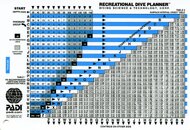Because some readers may not have access to PADI tables, I'm going to take a risk here and attach an image of one side of the PADI air table so that you can see how I came to the 7 minute number. If there are copyright issues, please feel free to remove the image. (It's only one side, and it really can't be used properly if I don't post the other side, so I'm hoping it passes moderation for purposes of illustrating the discussion.)I don't know that I have quantified this with my students, but I like it! What made you settle on 7 minutes?I already give a lot of practical emphasis to watching the NDL on the computer and telling my divers (both students and fun divers) not to let the computer count down to less than 7 minutes NDL on the deep portions of our dives (>18 meters).
When you look at the recreational depth deep dives (which PADI defines as those from 18 meters/60 feet and beyond), you see that the shaded boxes at the extreme time limits for the dive are all omitted if we subtract 7 minutes from the black box NDL time limit. That is, at 60 feet, the NDL is 55 minutes; if we subtract 7 minutes from that, we get 48 minutes, which will keep the diver out of the gray area if s/he dives a square profile and sits at 60 feet for the entire dive. For the next depth column, 70 feet, by subtracting 7 minutes from the black box 40 minute NDL listed, we get 33 minutes, again outside the gray area. The next deeper depths, 80 and 90 feet get us well out of the gray area. Anything over 100 feet is a contingency depth and we are meant to teach students to stay shallower than 100 feet.
In other words, there's nothing magic about 7 minutes. It's just convenient to have a single number to recommend to people, and you know that if they lose track while shooting a picture or something and go down to 6 or even 5 minutes, they're still well within limits.
I make the recommendation for shallower dives, too, especially if we're doing three or more dives and have been deep on the early dives. To be honest, I don't often come very close to bumping limits on those since the NDL times are so long (over an hour), unless we've had a realatively short surface interval after a series of deep dives. This can certainly happen on the liveaboards, but not so much on the day boats.




